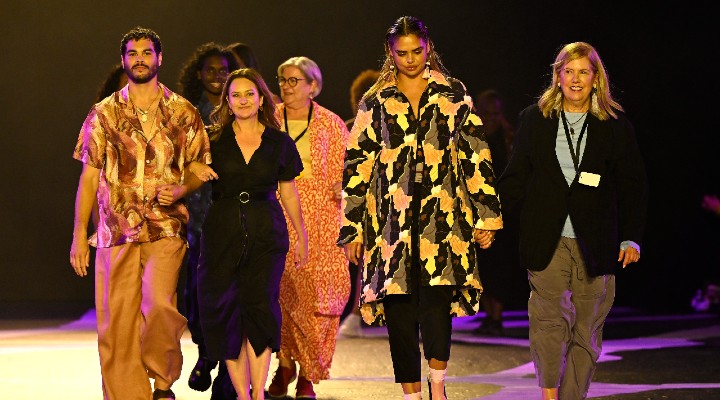A collective of Indigenous fashion designers has just returned from a trip to Europe, where they showcased a series of fashion shows in Brussels, London and Dublin. Sponsored by the Department of Foreign Affairs and Trade (DFAT) and organised by fashion designer and Wonnarua woman Amanda Healy, the aim of the tour was to highlight Australian art and design. Designers on the trip included Kirrikin, Liandra Swim, Maara Collective and Ngali. The runway shows coincided with international initiatives
ves by the Embassies, which included highlighting Aboriginal artworks in Brussels.
“I’ve lived here long enough to know it’s hard to make profit on your own land. Particularly in fashion and design, it seems you have more kudos when you make it overseas. It’s a weird thing, isn’t it?” Healy told Inside Retail.
“Indigenous issues are really never taken seriously until someone outside of Australia has a look. But also, in a way, there is more sympathy for Indigenous issues in other countries. From Kirrikin’s very early stages, I have always been interested to show the brand on an international stage.”
Healy hopes that the trip also provides opportunities for the designers to build contacts within the international fashion scene. For example, the group of designers have recently established a relationship with Dutch fashion school Ursulinen Mechelen in Belgium.
“We will also seek to connect with agents, stylists and other London fashion scene professionals to establish those that are worth engaging with for the longer-term plans of the Indigenous Fashion community. It will ultimately be our aim to have our products wholesaled into Europe,” she said.
“The purpose of these shows is to provide a much broader scope for our Aboriginal businesses and creatives, but also to open our store fronts to the world.”
Indigenous design on the runway
The fashion labels on tour are also part of the Indigenous Fashion Projects run by the Darwin Aborignal Art Foundation, which has just come off the runway at Afterpay Australian Fashion Week. High-profile Indigenous models including Nathan McGuire, Samantha Harris and Magnolia Maymuru took part and singer Jessica Mauboy closed the show to much fanfare.
“I thought the runway was particularly beautiful,” said Healy. “It is quite purposeful and regardless of whether we call it or not, every one of our businesses is a social enterprise, they always go back to the community – it’s the nature of the way things are. I’m happy to see that there’s a real community impact, it’s part of our economic development as a group of people.”
Healy is particularly excited about the next generation of Indigenous designers, as Aboriginal fashion is finally being embraced during Fashion Week. This was the second year that Indigenous runways were showcased during the event earlier this month.
“No matter what ethnicity people are, as soon as one person starts to do it, it becomes so much easier for anyone else. It’s like kicking down doors, but whatever way you describe it, the first one who makes it through makes it easier for us others because others can see it’s possible,” said Healy.
“There certainly is a proliferation of young designers coming up, testing the waters to how they can exist in this space. It’s actually amazing to see all these young ones come up. They can make two or three dresses, go away for a while and come back in a couple of years with more capabilities, experience and a better range. I actually think we’re going to look pathetic beside them in a few years’ time!”
Changing perceptions on home turf
First Nations fashion is certainly in the spotlight at the moment, especially as the industry has focused on supporting local talent since Covid hit. For example, the latest issue of Vogue magazine features four Aboriginal women on the cover, including Australia’s first ever Indigenous model, Elaine George. Meanwhile, more mainstream brands such as Wittner, Adairs and Breville have begun collaborating with Indigenous designers.
However, Liandra Gaykamangu, founder of Liandra Swim and Yolgnu woman, is cautious of the rise in these kinds of partnerships, as she explained during a panel discussion at Fashion Week.
“When I see some brands [doing collaborations], I think, what could you possibly be getting out of this beyond just a dollar and the fact that you know it will sell? And what does that do for the Indigenous business that’s already in this space and working hard, and you’ve just cut in on their opportunity to trade in their own culture and represent themselves, their family and who they are?” said Gaykamangu.
“My next question is always around, how is this being done? Is it an ethical deal?”
As for the future of Indigenous design in Australia, Healy hopes that current and emerging designers are slowly shifting people’s perceptions away from “cheap souvenir products” and “$4.99 boomerangs made overseas”.
“I’d love to see broader Australia embrace us and acknowledge us and be seen as not Indigenous designers, but great Australian designers who happen to be Indigenous,” she said. “I’d love for people to buy our products because they love them, they’re beautiful and they truly represent who we are as a country and the stories of our country.”

